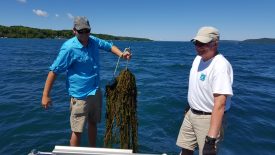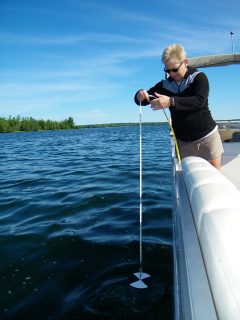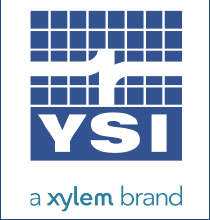Joy Ramstack Hobbs has been working with the WALPA Volunteer Lake Monitoring committee to further their efforts in starting a statewide lake monitoring program. One of the first tasks has been to research successful programs in other states. Below is a summary of Michigan’s Cooperative Lakes Monitoring Program.
Summary
Michigan has had a successful volunteer monitoring program since 1974. Throughout the program’s history, its focus has been on volunteers, both in collecting data of interest to the public, and educating citizens on lake ecology and management. The program is administratively complex, but is designed to be easy for volunteers to navigate. Numerous training manuals and videos are available on the website, and the on-line database is user-friendly. One of the program staff, Jo Latimore, was extremely helpful in answering questions about the program and providing advice for WALPA.
Goals
- Measure baseline water quality and document water quality trends on participating lakes
- Educate the public in lake ecology, lake management practices, and procedures for collecting water quality data
- Build public support for lake quality protection and encourage sound lake management practices.
- Provide a cost-effective way for Michigan’s Department of Environmental Quality (DEQ) to increase baseline water quality data for inland lakes statewide.
Partners
- Michigan Department of Environmental Quality (DEQ)
- Michigan Lake and Stream Association (MLSA)
- Michigan Clean Water Corps (MiCorps)
- Great Lakes Commission (GLC)
- Huron River Watershed Council
- Michigan State University (MSU) Department of Fish and Wildlife
History and structure
The Michigan DEQ currently administers the Cooperative Lakes Monitoring Program (CLMP) jointly with the Michigan Lake and Stream Association (MLSA). The CLMP currently operates as a program under the Michigan Clean Water Corps (MiCorps), Michigan’s volunteer surface water monitoring network.
The Michigan DEQ began citizen-based volunteer monitoring in 1974 with the Self-Help program, making Michigan’s volunteer lake monitoring program the second-oldest in the country. When the program started, only Secchi depth was monitored. In 1992, in cooperation with the MLSA, the program expanded to include TP measurements and was renamed the CLMP (additional parameters have since been added). Since the early 2000’s, CLMP has been a program under MiCorps, which also administers a volunteer stream-monitoring program.
MiCorps was created in 2003 to help the DEQ collect and share water quality data to use in water resources management and protection programs. The Great Lakes Commission partners with the Huron River Watershed Council and MLSA to develop, implement, and administer MiCorps, under the direction of the DEQ and with the advice of a steering committee. Michigan State University’s Department of Fish and Wildlife also provides technical assistance for CLMP.
Funding
Since the program’s beginnings, funding for MiCorps/CLMP comes from the state, through the Michigan DEQ. The current contract from the DEQ was granted to the GLC for a three year program at a cost of $695,000, which funds both the lake and stream monitoring programs. Included in the contract is $160,000 for GLC staff salaries and benefits, as well as a subcontract to the Huron River Watershed Council (about $200,000, primarily for the stream monitoring program), a subcontract to MLSA (about $100,000) and a subcontract to Michigan State University. Program staff Jo Latimore said that although the budget includes money for items like facilities for volunteer trainings, the majority of the $695K covers personnel costs.
Beyond the $695K contract, the DEQ also contributes a staffperson working with MiCorps (roughly half-time) and the cost of sample analysis (TP and chlorophyll a).
The CLMP does charge its volunteers to participate. The most basic enrollment (Secchi depth only) is $40 per year, and there are additional charges for each parameter, covering the costs of supplies and mailing. Jo estimates that the average group pays about $150 per year for monitoring one lake. The training sessions, as well as access to MiCorps staff, are free to all volunteers. Jo believes that charging participants often leads to an increased level of commitment, and CLMP hasn’t seen a downside. The program was created to educate citizens and having them participate in lake management; they pay a modest amount for that education and participation.
Parameters Monitored, Monitoring Frequency, and Participant Fees
- Basic Parameters (New and experienced participants may enroll)
- Secchi disk transparency: $40 (weekly, mid-May through mid-September)
- TP: $25 per sampling (two samples collected; spring overturn and late summer)
- Lakeshore Habitat Assessment: $25
- Exotic aquatic plant watch: $25
- Advanced Parameters (Participants can enroll after one or more years in the CLMP)
-
- o Chlorophyll a: $60 (once per month, May through September)
- o Dissolved oxygen/temperature: $50 (profiles every two weeks from mid-May through mid-September)
- o Aquatic plant identification and mapping: $250 first year, $50 subsequent years
-
While the monitoring frequencies listed above are considered ideal, MiCorps will accept data collected less frequently.
MiCorps has extensive on-line training manuals (and videos) that could be very useful for WALPA.
Data Handling
Data is handled through the MiCorps Data Exchange (MDE) platform; MDE provides online access to data through a searchable database. The MDE accepts data from CLMP volunteers and from other groups, and categorizes the data based on how it is collected.
The database is available through the MiCorps website (https://micorps.net/data/view/); it’s easy to view online or extract to Excel. All CLMP participants have a username and password and are encouraged to enter their own data, but MiCorps staff will help with data entry when necessary.
End Users
The primary users of the MiCorps dataset are the volunteers themselves. Additionally, the DEQ uses some of the data in its reporting to the EPA, and the Michigan Department of Natural Resources uses it for information on managing fisheries and fish stocking decisions. Researchers working with MSU and other universities to build a large database of lake monitoring data have been pleased with the quality of the MiCorps data and it has been included in their study.
In some cases, CLMP volunteers have collaborated with researchers who have proposed extra data collections; these additions have worked well, but Jo cautions that MiCorps staff has been protective of its volunteers and their needs. For example, staff makes sure that researchers provide summary reports in a timely fashion so that the volunteers benefit from their involvement.
Number of Volunteers
In 2015, 396 volunteers monitored 230 lakes under the program.
Number of Staff
There are five MiCorps staff members (each affiliated with one of the partner agencies), who provide a joint estimated time commitment of 1.9 FTE.
Advice for WALPA
Jo Latimore had several pieces of advice for WALPA about starting a volunteer lake monitoring program:
Be careful about the number of monitoring parameters the group starts with; don’t take on too much at once.
Create a clear structure within which volunteers can successfully and comfortably work.
Determine with the volunteers how the program should expand. When MiCorps was looking to add another monitoring parameter, they asked the volunteers, who overwhelmingly agreed on adding a shoreline assessment.
Do not underestimate the amount of staff time it takes to recruit, register and retain volunteers and answer their questions.
Key to volunteer retention is direct access to program staff who respond promptly.
The social benefits of the program (provided by training sessions and an annual conference) have been valuable in recruiting and keeping dedicated volunteers.
Sources
- http://www.michigan.gov/deq/0,4561,7-135-3313_3681_3686_3731-195536–,00.html (March 2017)
- https://micorps.net/ (March 2017)
- Personal Communication with Jo Latimore (MiCorps/MSU), March 29, 2017











